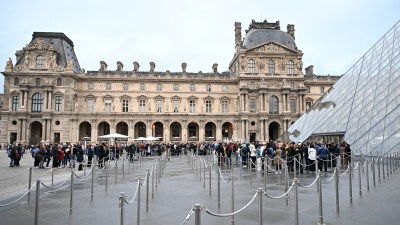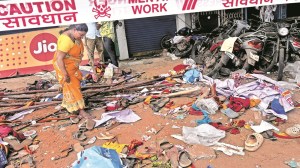On Civvy Street, there’s no road ahead
Every year about 60,000 defence personnel retire because they see limited possibilities of promotion. In the services, 82 per cent of off...

Every year about 60,000 defence personnel retire because they see limited possibilities of promotion. In the services, 82 per cent of officers and 74 percent of enlisted men remain at the lowest rank in their class. They find themselves cashiered as middle age catches up with them, because service rules demand a higher degree of physical fitness at lower ranks. The result: the Army loses 87 per cent of its personnel by the age of 45.
And so the nightmare begins. Untutored in the civilian trades, with half their life still before them, they find themselves on a pension that is lower than that of a peon, and with no access to the health-care that is a given in a government job.
The defence services account for only 6 per cent of all pensionable jobs. Central and state government employees retire at 58 or 60 years and qualify for a full pension. Defence personnel do not because they don’t complete the stipulated term of 33 years.
A sepoy’s pension is between Rs 1,275 and Rs 1,570, depending upon his lengthof service. A peon in government employment gets Rs 2,000 and service for about 35 years till the age of 60. He retires after discharging most of his financial liabilities. The soldier, on the other hand, is hard-pressed to maintain his family on his meagre pension. The human development indices are against him, as one Army man wryly pointed out. Life expectancy has increased from 64 years in 1950 to 77 years at present, so the soldier has a longer road ahead of him after retirement.
The soldier’s primary problem after early retirement is employment. The Ministry of Defence has tried to address this, but the results have been indifferent. A full-fledged mechanism consisting of 336 Zila Sainik Boards and 29 Rajya Sainik Boards under the state governments and the Director General of Resettlement at the Ministry of Defence has been at work since 1954. But it has enjoyed only limited success in helping retirees find employment.
Training and education in the defence services do not prepare personnel for thecivilian job market. Only 39 per cent of officers and 13 per cent of junior commissioned officers and other ranks attend the short-term rehabilitation courses conducted by the Ministry of Defence. Only 25 to 30 per cent of ex-servicemen get re-employment through various schemes such as re-employment within the defence services, and only for two to four years. Every year, approximately 1,500 officers are re-employed in the Army, 167 in the Navy and 275 in the Air Force. The scheme only covers officers of the level of colonel and lieutenant colonel or equivalent.
The private sector accommodates only 4 to 6 per cent of retirees. Again, this is for only two to four years. The Supreme Court ruling (a fallout of the Mandal Commission report) disallowing reservations above 50 per cent has compounded the problem. Besides, the Sainik Boards and the Ministry of Defence have no record of ex-servicemen’s caste status.
There should be ensured re-employment for defence personnel until the age of 58 to 60 years. Therecommendations of the Fifth Pay Commission should be implemented. The ex-servicemen should be adjusted in defence, civilian and central police organisations; they have a strengt of 6.73 lakh and 5 lakh respectively against a total strength of 12 lakh in the defence services.
In Group A posts, Himachal Pradesh, Punjab, Karnataka and Haryana have reservations of 15, 13, 10 and 5 per cent respectively. No other state or public sector unit or the central government has any reservations for ex-servicemen.
In Group B posts, the same reservations are there in the above states. In addition, Manipur has a 10 per cent reservation in para-military services and 2 per cent in other services.
In Group C posts, out of 29 states and UTs only 13 have provided 10 to 15 per cent reservations. Central government and public sector units have 10 to 14.5 per cent reservation.
In Group D posts, only 16 states have reservations between 10 to 20 per cent, eight states have 1 to 5 per cent and central government and publicsector units have 20 to 24.5 per cent reservations. Of the lot, only 13.48 to 20.91 per cent of reserved posts are filled.
Employment is only the biggest of a myriad problems facing the man just out of uniform. The absence of medicare is another issue. Ex-servicemen are scattered all over the country but defence medical units are located only at cantonments and are intended for serving men. While 50 lakh government servants and their dependents are covered under the CGHS and AMA schemes, there is no safety net for retired defence personnel and their wards.Widows of defence personnel present another problem.
From 1993 to 1998 alone, more than 1,500 personnel have lost their lives in various operations. Many more have been disabled. Under the existing provisions, compassionate appointment can be given to the widow or dependent of the deceased, but the system has been decentralised to the ministry and departmental level, where the quota is 5 per cent.
The CGHS and AMA schemes should cover defencepersonnel, or a parallel scheme should be drawn up. The government has sanctioned a medical allowance of Rs 100 per month to all pensioners. Since 90 per cent of defence personnel retire before the age of 50 and have responsibilities, a 10 per cent annual increase would be in order.
Payments and reimbursements should be made through the Kendriya Sainik Board based on a system of recognised hospitals and doctors. Immediate employment should be given to widows or to one of her dependents. Disabled solders should be entitled to selective rehabilitation with full pay. If this is not possible, they should be given the last pay drawn with the usual increments, as the man would have got further promotions had he been not disabled.
Serving men spend the best years of their life in harness, cut off from their families because the Army has family accommodation for only 14 per cent of its personnel. When they return to their homes, it is as inadequate heads of families, without jobs, social security or a futurethat’s worth having.





- 01
- 02
- 03
- 04
- 05


























